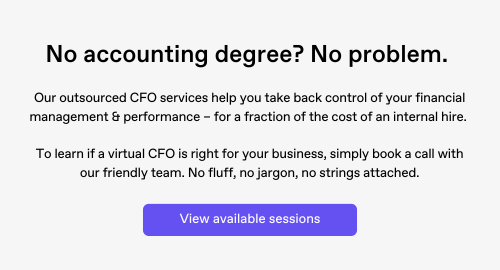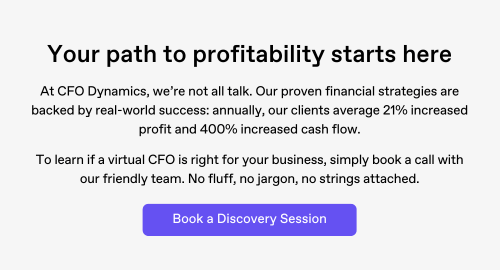How Much Cash Should Your Business Have?
How much cash should your business keep on hand? Cash can be a very emotive subject for people, so it’s a question that doesn’t always have a straightforward answer. Too little cash can leave your business vulnerable to sudden expenses, while too much cash sitting idle could mean missed opportunities for growth. In today’s competitive landscape, getting this balance right is crucial. This article explores how you can determine the ideal cash reserve for your business, ensuring you’re ready for both challenges and opportunities.
IN THIS ARTICLE
→ The double-edged sword of cash reserves
→ Signs you might be holding too much cash
→ The balance between comfort and data
→ How much cash do you need to sleep at night?
→ Learning from Warren Buffett: Cash management tips
→ Using Financial Metrics to Guide Your Cash Decisions
→ Understanding the numbers: GP% and WC% explained simply
→ Why the gap between GP% and WC% matters
→ What does a healthy gap look like?
→ What to do if your cash reserves are out of balance
→ Cash Benchmarks for Businesses
→ How to set benchmark for your cash reserves
→ Conclusion
Does Your Business Have Enough Cash?
The double-edged sword of cash reserves
It might seem logical to think that more cash always equals more security. However, having too much cash on hand can be just as detrimental as having too little. Excessive cash reserves might make you feel secure, but they can also indicate inefficiency—money that could be better invested in growing your business is simply sitting idle. On the flip side, too little cash means your business might not withstand a downturn or unexpected expenses. The key is finding the sweet spot where your cash reserves are working for you, not against you.
Signs you might be holding too much cash
Are your cash reserves aligned with your business needs? If you’re unsure, it’s time to evaluate. One clear sign that you might be holding onto too much cash is if your reserves consistently exceed three months’ worth of fixed costs without a specific plan for reinvestment or distribution. Another sign is if your business is generating sufficient cash flow, yet the money remains in your account instead of being used to fuel growth. Regularly reviewing your cash flow and reserves can help you identify whether you’re sitting on too much cash.
The balance between comfort and data
Determining the right amount of cash for your business involves balancing subjective comfort with objective data. On the subjective side, consider how much cash you need to feel secure. This varies from person to person—some business owners prefer a large cushion, while others are comfortable with less. On the objective side, you’ll need to look at financial metrics such as gross profit percentage (GP%) and working capital percentage (WC%). These figures will give you a more precise understanding of your cash needs.
How much cash do you need to sleep at night?
Your personal comfort level plays a significant role in determining your cash reserves. Think about how much cash you need to feel secure in your business. This number is subjective and can vary greatly depending on your risk tolerance and confidence in your business’s future. While it’s important to ensure you’re comfortable, this should be balanced with the hard data to avoid holding excessive cash that could be better used elsewhere.
Learning from Warren Buffett: Cash management tips
Warren Buffett, one of the most respected investors globally, has two principles that can be applied to your business’s cash management:
-
Set a minimum cash reserve: Buffett keeps a minimum $30billion (yes, billion with a ‘b’!) cash reserve at Berkshire Hathaway to ensure stability. You can apply this by setting a minimum reserve based on your business’s fixed costs, ensuring you’re prepared for any unexpected expenses.
-
Invest excess cash: Buffett believes in putting excess cash to work rather than letting it sit idle. For your business, this might mean reinvesting in growth opportunities or returning money to shareholders.
Using Financial Metrics to Guide Your Cash Decisions
While personal comfort is important, data-driven decisions are crucial for effective cash management. The gap between your gross profit percentage (GP%) and working capital percentage (WC%) is a key metric in determining how much cash your business should hold. A larger gap, with GP% higher than WC%, indicates that your business is generating extra cash efficiently, reducing the need for large reserves.
Understanding the numbers: GP% and WC% explained simply
To make informed decisions about your cash reserves, you need to understand two key metrics:
-
Gross profit percentage (GP%): This is calculated by dividing your gross profit by your total revenue. It shows how efficiently your business is turning sales into profit after accounting for the cost of goods sold (COGS). A higher GP% indicates better profitability.
-
Working capital percentage (WC%): Working capital is the money your business uses for day-to-day operations, calculated as current assets minus current liabilities. The WC% is this figure expressed as a percentage of your annualised revenue, providing insight into your business’s liquidity.
Why the gap between GP% and WC% matters
The gap between your GP% and WC% is a critical factor in your cash management strategy. The bigger the gap, with GP% on top, the easier it is for your business to generate extra cash. This positive gap means that your business is running efficiently, producing more cash from its operations and reducing the need for large cash reserves.
Cash Benchmarks for Businesses
How to set benchmark for your cash reserves
To manage your cash reserves effectively, it’s important to set benchmarks. A good rule of thumb is to keep enough cash on hand to cover three months’ worth of fixed costs, including COGS, overheads, and debt repayments. This benchmark ensures that your business can weather unexpected expenses while also not holding excessive cash that could be used more effectively elsewhere.
What does a healthy gap look like?
A 15% gap between your GP% and WC% is generally considered healthy. If your gap is 15% or higher, your business is likely generating sufficient cash flow, reducing the need for large reserves. If the gap is smaller, it may be time to reassess your cash management strategy.
What to do if your cash reserves are out of balance
If you find that your cash reserves are either too high or too low, here are three practical steps you can take:
-
If you have too little cash: Consider strategies to increase your reserves, such as improving your GP%, cutting unnecessary expenses, or securing additional funding.
-
If you have too much cash: Look at ways to put that money to work. This could mean reinvesting in your business, returning funds to shareholders, or exploring new growth opportunities.
-
Regularly review your cash flow: Make it a habit to reassess your cash reserves and financial metrics regularly to ensure they remain aligned with your business goals.
Conclusion
Managing your cash reserves is about finding the right balance. Too little cash can leave your business vulnerable, while too much can lead to missed opportunities. By combining subjective comfort with objective data, and setting clear benchmarks, you can ensure your business is both stable and ready to grow.
At CFO Dynamics, we help businesses optimise their cash reserves, ensuring they’re prepared for the unexpected while still seizing growth opportunities. If you want to get your cash flow under control, let’s discuss how we can support your financial success. Simply find a time that suits you and schedule a free, no-strings attached call with our friendly team.




